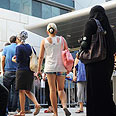
August unemployment reaches 6.9%
Number of unemployed Israelis aged 15-64 up from 236,000 in July to 251,000 in August, Central Bureau of Statistics says. Q2-2012 sees rise in available jobs, from 63,000 in late March to 69,000 in late June
Israel's unemployment rate reached 6.9% in August, compared to 6.6% in July, according to figures released by the Central Bureau of Statistics (CBS).
The number of unemployed Israelis aged 15-64 increased from 236,000 in July to 251,000 in August.
The workforce participation rate, on the other hand, rose from 64.1% in July to 64.3%. The population's total employment rate remained similar to the previous month – 59.9%.
The CBS also updated the employment rate for the month of July from its first estimate of 6.5% to 6.6%. The unemployment rate among Israelis over the age of 25 increased from 5.6% to 5.8% and the workforce participation rate rose significantly – from 78.8% to 79.5%.
Supply of jobs
Additional figures were published regarding the supply of jobs in the second quarter of 2012. According to the data, the second quarter saw a rise in the number of available jobs in Israel – from 63,000 in late March to 69,000 in late June.
An increase was also recorded in the number of full-time positions, with 5,000 more people reporting that they worked at least 35 hours a week.
The greatest demand for workers at the end of the second quarter of 2012 was recorded in the industrial sector and the construction industry, the hotel and food industry, and the commercial and wholesale sector.
Only 1.8 candidates competed for each job in the hotel and food industry. The demand-to-supply ration in the commercial and wholesale sector was 1:1, meaning the number of job seekers equaled the number of available jobs.
The construction industry also registered a ratio of almost 1:1 between job seekers and available positions. The industrial sector recorded a high demand for drivers, with 3.2 candidates competing over each position.
The lowest demand was recorded for unprofessional workers, with more than five candidates competing for every job, and for managers – five candidates for every job.
Among academics, two candidates competed for each job. Of the academic professions, the number of available jobs surpassed the number of job seekers in the engineering and architecture professions.










